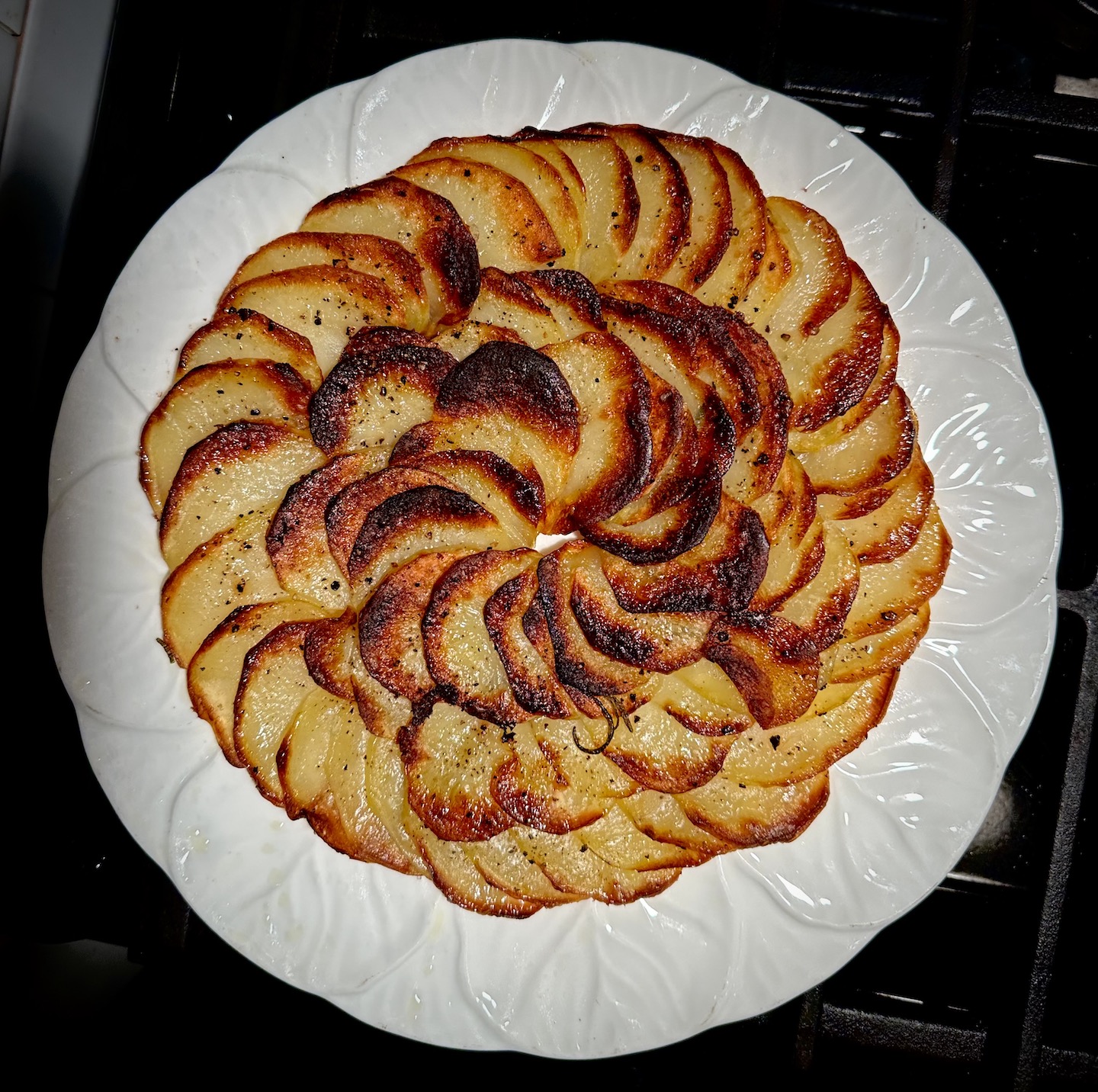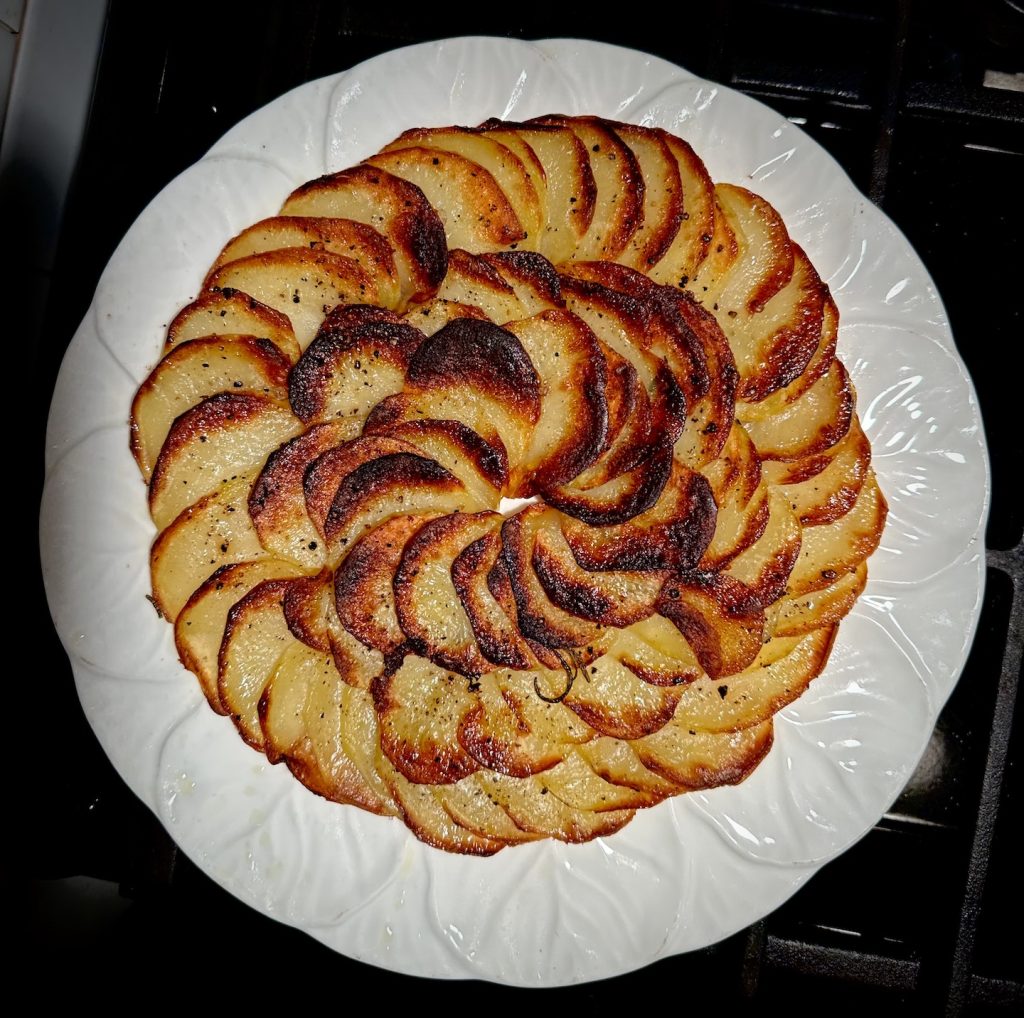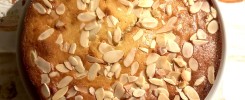Potato Galette is a skinny, single-layered version of the French classic Pommes Anna. The delicious caramelized, crunchy edges and creamy centers make this potato dish a keeper! Although it looks complicated, it's easy enough to assemble. Thinly sliced, slightly starchy potatoes like golds or red Bliss, are tossed in a little olive oil and fresh rosemary then laid onto a non-stick frying pan in an overlapping, tight rosette. The only tricky bit is flipping the galette over with a plate to brown the other side, but if you start it off over low heat, are patient, and don't try to rush it, all will be well. Enjoy!
It's important to cook the potatoes slowly. Covering the pan over lowish heat acts a little like an oven. The potatoes cook through in their own steam without burning, releasing their starches to help the slices stick together. Meanwhile the edges of each slice gradually caramelize where they hit the hot bottom of the pan.

If you have a mandolin, slice the potatoes into rounds 1/16" thick. Be sure to use the guard!
If you don't have a mandolin, take a sharp knife and cut a thin slice off the bottom of each potato to create a flat surface to stabilize the spud as you cut it. Set the potato cut side down and thinly slice it across. Slice as thinly as you can. If a few slices come out thicker it's not the end of the world.
Whether using a mandolin or cutting by hand, discard any very small or uneven slices like the very ends, and reserve for another use.
To a large bowl, add 1 tablespoon of the olive oil and the rosemary. Tip in the sliced potatoes and toss to mix using your hands. Set aside.
Add 1 tablespoon of the remaining olive oil to a 10" non-stick pan. Heat it over a medium flame to thin the oil and swirl to coat. Remove from the heat.
Using the largest rounds of oiled potato first, make a circle of potato slices around the outside edge of the pan, tightly overlapping them as you go until you complete the circle by tucking the last slice under the first. Start a new circle, half covering the first. Continue until you have a tight rosette of potatoes filling the pan. I find some of the smaller pieces useful to fill out the center. Sprinkle with sea salt and a rind or two of black pepper. Return to the stove over a medium flame. Cover. Cook for 10-15 minutes, checking about halfway through. If the edges are browning too fast turn the flame down a notch.
After 10 minutes, check again. The edges should be starting to brown. Gently test the thickest potatoes for doneness with a fork. The potato slices should have shrunk somewhat, be soft but still hold their shape. The rosette will look flatter now. If any of the potatoes are still a little hard, cover and cook 2-5 minutes more, still over a medium flame.
Time to turn the galette. You will need a dinner plate large enough to completely cover the galette, and a pair of oven gloves.
Remove the pan from the stove. Cover the galette with the plate, and putting one gloved hand firmly on the plate, flip the pan over with the other and lift it off the plate. The browned side of the galette will be now be facing you on the plate. Don't worry if it is a little wonky. Return the pan top the stove over a medium flame and add the remaining oil if needed. When the pan is hot, carefully slide the galette back into the pan. Tidy up the rosette shape if you need to. Cover and cook another 10 minutes.
To finish: Raise the heat a notch to medium/medium-high. Remove the cover. Cook 5 minutes more to dry the galette out and finish crisping the edges. To serve: either repeat the flip but this time onto a serving plate as in the picture, or you can serve directly from the pan.

About the potatoes:
- You can use Idaho of Russet potaoes for this but they are floury in texture and can get crumbly instead of holding their shape, so I prefer to use the less starchy gold or bliss potatoes.
- It's important to cook the potatoes slowly over a medium heat. Covering the pan over lowish heat acts a little like an oven. The potatoes cook through in their own steam without burning, releasing their starches to help the slices stick together. Meanwhile the edges of each slice gradually caramelize where they hit the hot bottom of the pan. Looks pretty, tastes good!
You can make the galette in a non-stick omelet or crepe pan for an easier flip.
- Dried woody herbs like rosemary are twice as strong as fresh, so you need half as much.
Ingredients
Directions
If you have a mandolin, slice the potatoes into rounds 1/16" thick. Be sure to use the guard!
If you don't have a mandolin, take a sharp knife and cut a thin slice off the bottom of each potato to create a flat surface to stabilize the spud as you cut it. Set the potato cut side down and thinly slice it across. Slice as thinly as you can. If a few slices come out thicker it's not the end of the world.
Whether using a mandolin or cutting by hand, discard any very small or uneven slices like the very ends, and reserve for another use.
To a large bowl, add 1 tablespoon of the olive oil and the rosemary. Tip in the sliced potatoes and toss to mix using your hands. Set aside.
Add 1 tablespoon of the remaining olive oil to a 10" non-stick pan. Heat it over a medium flame to thin the oil and swirl to coat. Remove from the heat.
Using the largest rounds of oiled potato first, make a circle of potato slices around the outside edge of the pan, tightly overlapping them as you go until you complete the circle by tucking the last slice under the first. Start a new circle, half covering the first. Continue until you have a tight rosette of potatoes filling the pan. I find some of the smaller pieces useful to fill out the center. Sprinkle with sea salt and a rind or two of black pepper. Return to the stove over a medium flame. Cover. Cook for 10-15 minutes, checking about halfway through. If the edges are browning too fast turn the flame down a notch.
After 10 minutes, check again. The edges should be starting to brown. Gently test the thickest potatoes for doneness with a fork. The potato slices should have shrunk somewhat, be soft but still hold their shape. The rosette will look flatter now. If any of the potatoes are still a little hard, cover and cook 2-5 minutes more, still over a medium flame.
Time to turn the galette. You will need a dinner plate large enough to completely cover the galette, and a pair of oven gloves.
Remove the pan from the stove. Cover the galette with the plate, and putting one gloved hand firmly on the plate, flip the pan over with the other and lift it off the plate. The browned side of the galette will be now be facing you on the plate. Don't worry if it is a little wonky. Return the pan top the stove over a medium flame and add the remaining oil if needed. When the pan is hot, carefully slide the galette back into the pan. Tidy up the rosette shape if you need to. Cover and cook another 10 minutes.
To finish: Raise the heat a notch to medium/medium-high. Remove the cover. Cook 5 minutes more to dry the galette out and finish crisping the edges. To serve: either repeat the flip but this time onto a serving plate as in the picture, or you can serve directly from the pan.

About the potatoes:
- You can use Idaho of Russet potaoes for this but they are floury in texture and can get crumbly instead of holding their shape, so I prefer to use the less starchy gold or bliss potatoes.
- It's important to cook the potatoes slowly over a medium heat. Covering the pan over lowish heat acts a little like an oven. The potatoes cook through in their own steam without burning, releasing their starches to help the slices stick together. Meanwhile the edges of each slice gradually caramelize where they hit the hot bottom of the pan. Looks pretty, tastes good!
You can make the galette in a non-stick omelet or crepe pan for an easier flip.
- Dried woody herbs like rosemary are twice as strong as fresh, so you need half as much.

